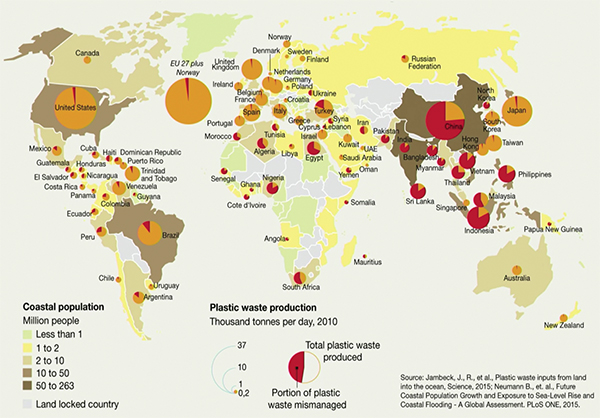Team Turn the Tide on Plastic finished last in the 2017-18 Volvo Ocean Race, but its crew collected key scientific data during the grueling event that provides an alarming look at the scope of plastic pollution at sea.
The team’s Volvo Ocean 65 monohull carried special sensors that were dropped into the ocean at various points throughout the around-the-world race. During stopovers, these samples were sent to a German lab that found microplastic particles nearly everywhere, including the most remote corners of the Southern Ocean.
Data collected during the first eight legs of the race were unveiled in Newport, R.I., in May during the Ocean Summit held in the race village.
“We’ve found microplastics, sadly, in nearly all of our samples,” Soren Gutekunst, a marine biologist at the GEOMAR Helmholtz Centre for Ocean Research in Germany, told the audience. “This shows how pervasive and vast the problem is already.”
Other scientific equipment on board the racing yacht collected data about ocean currents, surface temperatures and ocean acidification. The sensors used to collect microplastic data were roughly the circumference of a soda can.
Ocean plastic pollution is a growing problem with many causes and no easy solutions. Plastic production worldwide has increased twentyfold in the past five decades, and it is projected to double again within 20 years.
More than 90 percent of the plastic that enters the world’s oceans comes from 10 major rivers, eight of them in Asia, according to Dr. Lisa Svensson, director of the ocean and marine program at United Nations Environment. Not surprisingly, the coastal waters of China and other Southeast Asian countries yielded some of the densest levels of microplastics.
Insufficient waste management and sewage infrastructure is the leading cause of plastic pollution, Svensson said. Over time, plastic breaks down to “microplastic” particles smaller than 5 millimeters. Some estimates suggest more than 50 trillion of these particles exist in the oceans.
 |
“That also showcases the connection between land and ocean, and if we don’t take care of the waste, it goes through the rivers and it gets out into the ocean,” Svensson told the audience during the Newport event.
Studies have shown more than three-quarters of all plastic waste produced in China, India, Indonesia and the Philippines is not managed properly. The same is true in Nigeria and Senegal, two fast-growing economies in Africa. The United States and European Union, by contrast, mismanage only a tiny fraction of their plastic waste, although they also produce much more of it.
While many people are aware of the gyre of plastic waste swirling around the Pacific Ocean, they probably do not realize that microplastics affect marine life at all levels of the food chain. Dr. Rashid Sumaila, a professor at the University of British Columbia, said zooplankton consume microplastics in the water, and this contamination continues all the way to people who consume fish.
Major sources of plastic in the ocean include cigarette butts, shopping bags, drinking bottles, fishing nets, straws and large containers such as gas cans. Different plastics sink to different levels in the water column, making cleanup almost impossible.
There are several processes in place to stem the tide of plastic pollution, starting with programs at the United Nations. Individual governments are pledging action, including the G7 industrialized nations with the exception of the U.S. and Japan. India recently announced plans to ban single-use plastics by 2022.
Volvo Cars, Coca-Cola and McDonald’s are among the large corporations that have pledged to reduce plastic in their products. Other firms are experimenting with different materials for single-use items that biodegrade. Recycling offers another option to prevent plastic from entering rivers and oceans, and consumers can make choices that will help reduce plastic use.
In the U.S., the National Oceanic and Atmospheric Administration runs the Marine Debris Program aimed at preventing or removing trash from key waterways.
Taken together, Sumaila said, these efforts could have an impact.
“Plastic is one of multiple stresses on the system, and I think plastic is one we have a really good chance of dealing with,” he said. “We can take plastic out without reducing our quality of life.”

